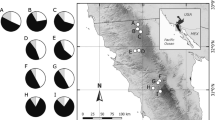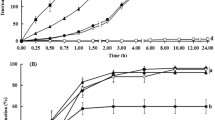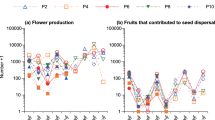Abstract
Bruchine beetles are usually considered seed predators, particularly because these beetles consume the seed embryo and kill the seeds. Previous studies suggest that under certain conditions, these insects do not kill the embryo. In this study, we asked whether the germination speed of seeds of the invasive tree Leucaena leucocephala is enhanced by the seed-feeding beetle Acanthoscelides macrophthalmus (Coleoptera: Chrysomelidae: Bruchinae). We also tested whether differences in germination between attacked and intact seeds could be related to seed size. We finally examined whether the number of larvae per seed affected seed germination and whether seedling emergence patterns were similar to those exhibited by germination. We found that compared to intact seeds, proportionally faster germination occurred in seeds attacked by A. macrophthalmus in 14 of the 26 populations studied. In addition, those populations that presented greater germination speed in the attacked seeds during the evaluation time also had the largest seeds. Similar to the germination experiments, seedling emergence was faster in the attacked compared to the intact seeds. Our findings show that the germination speed of L. leucocephala seeds can be enhanced by A. macrophthalmus. However, this effect is much more intense when a single larva develops inside the seed. In evolutionary terms, it is possible that the selection for larger seeds is favoured, increasing the speed of seed germination and contributing to predator satiation at the seed level. However, this effect could be minimized by the production of many seeds by L. leucocephala plants, causing predator satiation by “masting” effects, which would favour the selection for higher seed numbers.






Similar content being viewed by others
References
Arévalo JR, Afonso L, Naranjo A, Salas M (2010) Invasion of the Gran Canaria ravines ecosystems (Canary Islands) by the exotic species Acacia farnesiana. Plant Ecol 206:185–193
Austin PC (2017) A tutorial on multilevel survival analysis: methods, models and applications. Int Stat Rev 85:185–203
Baskin CC, Baskin JM (1998) Seeds: ecology, biogeography, and evolution of dormancy and germination. Academic Press, San Diego
Beckman NG, Neuhauser C, Muller-Landau HC (2012) The interacting effects of clumped seed dispersal and distance- and density-dependent mortality on seedling recruitment patterns. J Ecol 100:862–873
Bonal R, Muñoz A, Díaz M (2007) Satiation of predispersal seed predators: the importance of considering both plant and seed level. Evol Ecol 21:367–380
Branco M, Branco C, Merouani H, Almeida MH (2002) Germination success, survival and seedling vigour of Quercus suber acorns in relation to insect damage. For Ecol Manag 166:159–164
Cochard R, Jackes BR (2005) Seed ecology of the invasive tropical tree Parkinsonia aculeata. Plant Ecol 180:13–31
Costa CJ, Santos CP (2010) Teste de tetrazólio em sementes de leucena. Rev Bras Sem 32:66–72
Crawley MJ (2007) The R book. Wiley, Chichester
Dalmolin MFS, Malavasi UC, Malavasi MM (2011) Dispersão e germinação de sementes de Leucaena leucocephala (Lam.) de Wit na região Oeste do Paraná. Semina: C Agr 32:355–362
De Menezes LCCR, Klein J, Kestring D, Rossi MN (2010) Bottom-up and top-down effects in a pre-dispersal seed predation system: are non-predated seeds damaged? Basic Appl Ecol 11:126–134
Effowe TQ, Amevoin K, Nuto Y, Mondedji D, Glitho IA (2010) Reproductive capacities and development of a seed bruchid beetle, Acanthoscelides macrophthalmus, a potential host for the mass rearing of the parasitoid, Dinarmus basalis. J Insect Sci 10:1–14
English KF, Olckers T (2014) Does the size of the seeds and seed pods of the invasive tree Leucaena leucocephala (Fabaceae) affect their utilization by the biological control agent Acanthoscelides macrophthalmus (Chrysomelidae: Bruchinae)? Afr Entomol 22:872–879
Fenner M, Cresswell JE, Hurley RA, Baldwin T (2002) Relationship between capitulum size and pre-dispersal seed predation by insect larvae in common Asteraceae. Oecologia 130:72–77
Fox CW, Bush ML, Messina FJ (2010) Biotypes of the seed beetle Callosobruchus maculatus have differing effects on the germination and growth of their legume hosts. Agric For Entomol 12:353–362
Fröborg H, Eriksson O (2003) Predispersal seed predation and population dynamics in the perennial understory herb Actaea Spicata. Can J Botany 81:1058–1069
Haga EB, Rossi MN (2016) The effect of seed traits on geographic variation in body size and sexual size dimorphism of the seed-feeding beetle Acanthoscelides macrophthalmus. Ecol Evol 6:6892–6905
Harms KE, Dalling JW (2000) A bruchid beetle and a viable seedling from a single diaspore of Attalea butyracea. J Trop Ecol 16:319–325
Hubbell SP (1980) Seed predation and the coexistence of tree species in tropical forests. Oikos 35:214–229
Hulme PE, Benkman CW (2002) Granivory. In: Herrera CM, Pellmyr O (eds) Plant-animal interactions: an evolutionary approach. Blackwell, Oxford, pp 132–154
Jansen PA, Elschot K, Verkerk PJ, Wright SJ (2010) Seed predation and defleshing in the agouti-dispersed palm Astrocaryum standleyanum. J Trop Ecol 26:473–480
Janzen DH (1971) Seed predation by animals. Annu Rev Ecol Syst 2:465–492
Johnson CD, Romero J (2004) A review of evolution of oviposition guilds in the Bruchidae (Coleoptera). Rev Bras Entomol 48:401–408
Kadereit G, Newton RJ, Vandelook F (2017) Evolutionary ecology of fast seed germination—a case study in Amaranthaceae/Chenopodiaceae. Perspect Plant Ecol Evol Syst 29:1–11
Karban R, Lowenberg G (1992) Feeding by seed bugs and weevils enhances germination of wild Gossypium species. Oecologia 92:196–200
Kergoat GJ, Alvarez N, Hossaert-McKey M, Faure N, Silvain JF (2005) Parallels in the evolution of the two largest new and old World seed-beetle genera (Coleoptera, Bruchidae). Mol Ecol 14:4003–4021
Kestring D, Menezes LCCR, Tomaz CA, Lima GPP, Rossi MN (2009) Relationship among phenolic contents, seed predation and physical seed traits in Mimosa bimucronata plants. J Plant Biol 52:569–576
Kigel J, Galili G (1995) Seed development and germination. Marcel Dekker, New York
Koprdova S, Bellanger S, Skuhrovec J, Darmency H (2015) Does gall midge larvae cause pre-dispersal seed mortality and limit cornflower population growth? Acta Oecol 69:167–172
Koptur S (1998) Effect of seed damage on germination in the Common Vetch (Vicia sativa L.). Am Midl Nat 140:393–396
Lewis OT, Gripenberg S (2008) Insect seed predators and environmental change. J Appl Ecol 45:1593–1599
Lowe S, Browne M, Boudjelas S, De Poorter M (2000) 100 of the World’s worst invasive alien species: a selection from the Global Invasive Species Database. The Invasive Species Specialist Group (ISSG), a specialist group of the Species Survival Commission (SSC) of the World Conservation Union (IUCN), Hollands Printing Ltd, Auckland, NZ
McNair JN, Sunkara A, Frobish D (2012) How to analyse seed germination data using statistical time-to-event analysis: non-parametric and semi-parametric methods. Seed Sci Res 22:77–95
Medina-Rosa D, Fortes AMT, Mauli MM, Palma D, Marques DS, Corsato JM, Leszczynski R (2007) Potencial alelopático de Leucaena leucocephala (Lam.) de Wit sobre a germinação de sementes de plantas invasoras e soja. Rev Bras Bioc 5:525–527
Mendes S, Mesquita JB, Marino RH (2011) Qualidade sanitária de sementes de Leucaena leucocephala (Lam.) De Wit armazenadas em câmara fria. Nat Res 1:15–22
Mucunguzi P (1995) Effects of bruchid beetles on germination and establishment of Acacia species. Afr J Ecol 33:64–70
Nakai Z, Kondo T, Akimoto S (2011) Parasitoid attack of the seed-feeding beetle Bruchus loti enhances the germination success of Lathyrus japonicus seeds. Arthropod-Plant Interact 5:227–234
Neser S (1994) Conflicts of interest? the Leucaena controversy. Plant Protec N S Afr 6:8
Okello BD, Young TP (2000) Effects of fire, bruchid beetles and soil type on germination and seedling establishment of Acacia drepanolobium. Afr J Range Forage Sci 17:46–51
Oliveira AB (2008) Germinação de sementes de leucena (Leucaena leucocephala (Lam.) De Wit.), var. K-72. Rev Biol Ciênc Terr 8:166–172
Ollerton J, Lack A (1996) Partial predispersal seed predation in Lotus corniculatus L. (Fabaceae). Seed Sci Res 6:65–69
Orozco-Almanza MS, León-García LP, Grether R, García-Moya E (2003) Germination of four species of the genus Mimosa (Leguminosae) in a semi-arid zone of Central Mexico. J Arid Environ 55:75–92
Peguero G, Bonal R, Espelta JM (2014) Variation of predator satiation and seed abortion as seed defense mechanisms across an altitudinal range. Basic Appl Ecol 15:269–276
Perea R, San Miguel A, Gil L (2011) Leftovers in seed dispersal: ecological implications of partial seed consumption for oak regeneration. J Ecol 99:194–201
Perea R, López D, San Miguel A, Gil L (2012) Incorporating insect infestation into rodent seed dispersal: better if the larva is still inside. Oecologia 170:723–733
Perea R, Fernandes GW, Dirzo R (2018) Embryo size as a tolerance trait against seed predation: contribution of embryo-damaged seeds to plant regeneration. Perspect Plant Ecol Evol Syst 31:7–16
Pereira ACF, Fonseca FSA, Mota GR, Fernandes AKC, Fagundes M, Reis-Júnior R, Faria ML (2014) Ecological interactions shape the dynamics of seed predation in Acrocomia aculeata (Arecaceae). PLoS ONE 9:e98026
R Development Core Team (2018) R: a language and environment for statistical computing. R Foundation for Statistical Computing. Vienna, Austria. Version 3.5.1
Raghu S, Wiltshire C, Dhileepan K (2005) Intensity of pre-dispersal seed predation in the invasive legume Leucaena leucocephala is limited by the duration of pod retention. Austral Ecol 30:310–318
Ramírez N, Traveset A (2010) Predispersal seed-predation by insects in the Venezuelan Central Plain: overall patterns and traits that influence its biology and taxonomic groups. Perspect Plant Ecol Evol Syst 12:193–209
Ribeiro-Costa CS, Almeida LM (2012) Seed-chewing beetles (Coleoptera: Chrysomelidae: Bruchinae). In: Panizzi AR, Parra JRP (eds) Insect bioecology and nutrition for integrated pest management. CRC Press, Boca Raton, pp 325–352
Rodrigues LMS, Viana JH, Ribeiro-Costa CS, Rossi MN (2012) The extent of seed predation by bruchine beetles (Coleoptera: Chrysomelidae: Bruchinae) in a heterogenous landscape in southeastern Brazil. Coleopt Bull 66:271–279
Rose KE, Louda SM, Rees M (2005) Demographic and evolutionary impacts of native and invasive insect herbivores on Cirsium canescens. Ecology 86:453–465
Rossi MN, Rodrigues LMS, Ishino MN, Kestring D (2011) Oviposition pattern and within-season spatial and temporal variation of pre-dispersal seed predation in a population of Mimosa bimucronata trees. Arthropod-Plant Interact 5:209–217
Scherer LM, Zucareli V, Zucareli CA, Fortes AMT (2005) Alelopathic effects of aqueous extracts of leucena (Leucaena leucocephala Wit) leave and fruit on germination and root growth of canafistula (Peltophorum dubium Spreng). Semin-Ciênc Agrár 26:161–166
Sharratt MEJ, Olckers T (2012) The biological control agent Acanthoscelides macrophthalmus (Chrysomelidae: Bruchinae) inflicts moderate levels of seed damage on its target, the invasive tree Leucaena leucocephala (Fabaceae), in the KwaZulu-Natal coastal region of South Africa. Afr Entomol 20:44–51
Shoba Z, Olckers T (2010) Reassessment of the biology and host range of Acanthoscelides macrophthalmus (Chrysomelidae: Bruchinae), a seed-feeding beetle released for the biological control of Leucaena leucocephala in South Africa. Afr Entomol 18:1–9
Southgate BJ (1979) Biology of the Bruchidae. Annu Rev Entomol 24:449–473
StatSoft Inc (2012) Statistica (data analysis software system). Tulsa, OK, version 11.0
Stone BC (1970) The flora of Guam. Micronesica 6:1–659
Tadros MJ, Samarah NH, Alqudah AM (2011) Effect of different pre-sowing seed treatments on the germination of Leucaena leucocephala (Lam.) and Acacia farnesiana (L.). New For 42:397–407
Takakura K (2002) The specialist seed predator Bruchidius dorsalis (Coleoptera: Bruchidae) plays a crucial role in the seed germination of its host plant, Gleditsia japonica (Leguminosae). Funct Ecol 16:252–257
Takakura K (2004) Variation in egg size within and among generations of the bean weevil, Bruchidius dorsalis (Coleoptera: Bruchidae): effects of host plant quality and paternal nutritional investment. Ann Entomol Soc Am 97:346–352
Tomaz CA, Kestring D, Rossi MN (2007) Effects of the seed predator Acanthoscelides schrankiae on viability of its host plant Mimosa bimucronata. Biol Res 40:281–290
Tuda M (2007) Applied evolutionary ecology of insects of the subfamily Bruchinae (Coleoptera: Chrysomelidae). Appl Entomol Zool 42:337–346
Tuda M, Wu L-H, Tateishi Y, Niyomdham C, Buranapanichpan S, Morimoto K, Wu W-J, Wang C-P, Chen Z-Q, Zhu H-Y, Zhang Y-C, Murugan K, Chou L-Y, Johnson CD (2009) A novel host shift and invaded range of a seed predator, Acanthoscelides macrophthalmus (Coleoptera: Chrysomelidae: Bruchinae), of an invasive weed, Leucaena leucocephala. Entomol Sci 12:1–8
Tuller J, Paula EL, Maia LF, Moraes R (2015) Seed predation food web, nutrient availability, and impact on the seed germination of Senegalia tenuifolia (Fabaceae). Rev Biol Trop 63:1149–1159
Vallejo-Marin M, Dominguez CA, Dirzo R (2006) Simulated seed predation reveals a variety of germination responses of neotropical rain forest. Am J Bot 93:369–376
Vandenbussche F, Petrasek J, Zadnikova P, Hoyerová K, Pesek B, Raz V, Swarup R, Bennett M, Zazimalova E, Benkova E, Straeten D (2010) The auxin influx carriers AUX1 and LAX3 are involved in auxin-ethylene interactions during apical hook development in Aradopsis thaliana seedlings. Development 137:577–606
Visser MD, Muller-Landau HC, Wright SJ, Rutten G, Jansen PA (2011) Tri-trophic interactions affect density dependence of seed fate in a tropical forest palm. Ecol Lett 14:1093–1100
Williams RD, Hoagland RE (2007) Phytotoxicity of mimosine and albizziine on seed germination and seedling growth of crops and weeds. Allelopathy J 19:423–430
Wood A, Haga EB, Costa VA, Rossi MN (2017) Geographic distribution, large-scale spatial structure and diversity of parasitoids of the seed-feeding beetle Acanthoscelides macrophthalmus. Bull Entomol Res 107:322–331
Wu L-H, Wang C-P, Wu W-J (2012) Description and differentiation of the four larval instars of Acanthoscelides macrophthalmus (Coleoptera: Chrysomelidae: Bruchinae). Ann Entomol Soc Am 105:259–267
Xu Y, Shen Z, Li D, Guo Q (2015) Pre-dispersal seed predation in a species- rich forest community: patterns and the interplay with determinants. PLoS ONE 10:e0143040
Zar JH (1999) Biostatistical analysis. Prentice Hall, Upper Saddle River
Zhang M, Dong Z, Yi X, Bartlow AW (2014) Acorns containing deeper plumule survive better: how white oaks counter embryo excision by rodents. Ecol Evol 4:59–66
Acknowledgements
We thank Alicia Wood and Eloísa B. Haga for providing valuable assistance during the fieldwork. We also thank Daniela H. Maggio for help with the editing of Fig. 1 (map). We are grateful to the Fundação de Amparo à Pesquisa do Estado de São Paulo (Fapesp; no 12/11612-4) for financial support. We finally thank all the researchers from the Instituto de Botânica de São Paulo (IBT) for their assistance with the tetrazolium test. The biological material was collected according to the guidelines of the Authorization and Information System in Biodiversity (SISBIO – no 40133-1).
Author information
Authors and Affiliations
Corresponding author
Additional information
Publisher's Note
Springer Nature remains neutral with regard to jurisdictional claims in published maps and institutional affiliations.
Electronic supplementary material
Below is the link to the electronic supplementary material.
Rights and permissions
About this article
Cite this article
da Silva, A.V., Rossi, M.N. When a seed-feeding beetle is a predator and also increases the speed of seed germination: an intriguing interaction with an invasive plant. Evol Ecol 33, 211–232 (2019). https://doi.org/10.1007/s10682-019-09974-3
Received:
Accepted:
Published:
Issue Date:
DOI: https://doi.org/10.1007/s10682-019-09974-3




